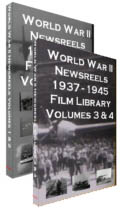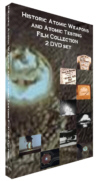Archive for the ‘World at War’ Category
After WWII, the Auschwitz death camp was turned into a museum to remember the horror that occurred there. Now 51 years later, there are plans to renovate the holocaust museum to ensure that it is preserved so future generations can still experience first hand the conditions and tortures of these concentration camps.
Plans include reinforcing the ground under two of the gas chambers with underground walls so they can stop sinking into the ground. Underground walls will be used to ensure that nothing is altered on these two death camp gas chambers. No changes would be made to the other parts of the holocaust camp – including the watch towers, crematoria and barracks – as they are still in good condition and not in danger of ground sinking like the two gas chambers.
Also slated is a revamping of the museum to make it more modern. While it will still hold its traditional Shoah (holocaust) exhibits – including hair, glasses and other personal belongings taken from the victims – it will expand to offer multimedia presentations to help explain the story of what happened there so many years ago.
Here is a great resource for those interested in nuclear weapons tests.
It is called
United States Nuclear Tests, July 1945 through September 1992
It is a chronological and alphabetical by name all nuclear tests and simultaneous detonations conducted by the United States. Detonation time and locations (latitude, longitude, and surface elevation) are included in the manual. Basically it is a one stop guide to the history of nuclear tests conducted by the United States before the nuclear weapon test ban.
It is in pdf format and is 185 pages long and fully indexed to make finding the particular nuclear weapons tests that you want quite easy. One if its most interesting features is the variety of maps showing where nuclear tests were conducted in both a large scale format and a grid format so you can get a really good feel for where each test was conducted in the larger testing area.
The Quartermaster Corps is able to trace its origins to 16 June 1775. On that day, following General Washington’s address command of the Army, the Second Continental Congress passed a resolution providing for “one Quartermaster General of the grand army and a deputy, under him, for the separate army.” Major General Thomas Mifflin, the first Quartermaster General, had no money to wrok with and overriding authority and was dependent upon the individual states for supplies for the army. The third Quartermaster General, Major General Nathanael Greene, reorganized the supply system after Valley Forge and established the first depot system to supply the Army with the goods it needed to function well. General Green is best known for his prowess as a battle leader but it is his work as Quartermaster General that has been amongst the most important innovations in the army.
From 1818 to 1860, the Quartermaster General was BG Thomas Sidney Jesup. He was a very capable administrator who took many steps to enhance the Corps’ reputation. During his 42-year tenure as head of the Quartermaster Department, he instituted an improved system of property tracking and accountability. He also experimented with new modes of transportation, including the use of canal boats in the east and camel caravans in the desert southwest. He also worked some of the earliest railroads. Because many of his policies remained in effect well into the 20th century, Jesup is traditionally regarded as the “Father of the Quartermaster Corps.” The supply of clothing and other items was taken over by the Quartermaster Department in 1842, a little more than halfway through his tenure.
During the Civil War, the Quatermaster Department was run under the capable leadership of MG Montgomery C. Meigs. He supplied the Union Army of over half a million strong, ran the Army’s first major depot system, and transported unprecedented levels of supplies and personnel throughout the war. It was his efficient running of the Quartermaster Department that helped win the war for the Union. Also, in 1862, the Quartermaster Department assumed responsibility for the burial of war dead and the care of the national cemeteries.
In 1912, Congress consolidated the former Subsistence, Pay, and Quartermaster Departments in order to create the Quartermaster Corps. While it has undergone changes since then, what was created in 1912 is much as we know it today. It is fully militarized with its own officers, soldiers, and units trained to perform a host of supply and service functions on the battlefield. With this consolidation came the missions of Subsistence and food service. And when the Army began purchasing motorized vehicles, as early as 1903, the Quartermaster Corps naturally assumed the new petroleum supply mission. Basically, anything that had to do with supplying the troops anywhere in the world under any conditions was rapidly falling under the pervue of the Quartermaster Corps.
World War I showed the increased importance of logistics in the modern era. From necessity, the the first use of specialized Quartermaster units on the Western Front were developed to ensure supply lines in foreign countries. Several “logistics warriors” were also singled out for valor in World War I and received the nation’s highest honors for bravery in battle.
During World War II, the Quartermaster Corps trained thousands of soldiers to fill specialized roles in every theater of operation-from the Pacific Isles and China-Burma-India theater to North Africa, Italy, and central and northern Europe. They performed heroically at such far off places as Bataan, Iwo Jima, Leyete, Salerno, Anzio, Normandy, and Bastogne. At the height of the war, Quartermasters were providing over 70,000 different supply items and more than 24 million meals each day. When it was over, they had recovered and buried nearly a quarter of a million soldiers in temporary cemeteries around the world. 4,943 Quartermaster soldiers lost their lives in World War II.
In 1950, the Quartermaster Corps moved swiftly to supply the United States and their UN allies sent to defend South Korea from the Communist North. That same year the Corps assumed a new mission-supply by air-which often proved crucial to the sustainment of troops on the Korean peninsula.
The 1965 decision to commit major United States combat forces to the Republic of Vietnam led to a massive logistics buildup. Quartermaster Corps personnel were deeply involved in meeting this challenge. They could be found operating in every area of Vietnam, furnishing vital supplies and services often under the most adverse and dangerous conditions.
Over the past decade, Quartermaster soldiers have been amongst the first deployed in operations Urgent Fury (Grenada) and Just Cause (Panama). They also provided the logistic support needed to defeat Iraqi forces during Operation Desert Storm. More recently Quartermasters have provided humanitarian relief to victims at home (hurricanes Andrew and Iniki) and abroad (Operations Provide Comfort, Restore Hope, Provide Promise, and Uphold Democracy).
Over the course of history quartermasters have performed a variety of tasks that match the evolution of the army. They have served as mule skinners, dog trainers, teamsters, bakers, launderers, typewriter specialists, shoe repairmen, depot operators, heraldry experts, paymasters, cemeterial custodians–and in other capacities too numerous to mention. In fact, the Quartermaster Corps is the most diverse branch of the army based on the many functions they provided throughout their history. But despite all the changes, the fundamental mission of the Corps has stayed the same: it is to support the individual combat soldier in the field.
No other branch of the Army can claim to have participated in so many missions, either historically or at the present.
No other branch of the Army touches the live of soldiers on a daily basis as much as the Quartermaster Corps. This has been the case since its inception in 1775.
http://www.jewishgen.org/databases/Holocaust/ offers a comprehensive database of over 1 Million holocaust victims and survivors. It is a powerful tool for anyone doing ancestor and relative research during the concentration camp horror of World War II.
In fact, the entire site is a tremendous resource for facts on the holocaust as they relate to people and events.
There is a fee to use the full features of some parts of the website but it offers a wealth of free informantion and if you do need to use the paid resources, the fees to do so are quite reasonable when you consider the vast archive of materials they have available.
This list includes all the vessels that were used as test vessels during Operation Crossroads and their disposition, when known.
Carriers
USS Independence (CVL-22) sunk as target off San Francisco, CA, 27 January 1951.
USS Saratoga (CV-3) sunk by Test Baker at Bikini, 25 July 1946.
Battleships
USS Arkansas (BB-33) sunk by Test Baker at Bikini, 25 July 1946.
Nagato (Japanese Battleship) sunk by Test Baker at Bikini, 29 July 1946.
USS Nevada (BB-36) sunk as target off Pearl Harbor, HI, 31 July 1948.
USS New York (BB-34) sunk as target off Pearl Harbor, HI, 8 July 1948.
USS Pennsylvania (BB-38) scuttled off Kwajalein, Marshall Islands, 10 February 1948.
Cruisers
USS Pensacola (CA-23) scuttled off the Washington Coast, 10 November 1948.
Prinz Eugen (IX-300) stranded and sank at Kwajalein, 22 December 1946.
Sakawa (captured Japanese heavy cruiser) sunk by Test Able at Bikini, 2 July 1946.
USS Salt Lake City (CA-25) sunk as target off San Clemente, California, 25 May 1948.
Destroyers
USS Anderson (DD-411) sunk by Test Able at Bikini, 1 July 1946.
USS Conyngham (DD-371) scuttled off California, July 1948.
USS Hughes (DD-410) sunk as target off Washington, 16 October 1948.
USS Lamson (DD-367) sunk by Test Able at Bikini, 1 July 1946.
USS Mayrant (DD-402) sunk off Kwajalein, 4 April 1948.
USS Mustin (DD-413) sunk off Kwajalein, 18 March 1948.
USS Ralph Talbot (DD-390) scuttled off Kwajalein, March 1948.
USS Rhind (DD-404) scuttled off Kwajalein, 22 March 1948.
USS Stack (DD-406) sunk as target off Kwajalein, 24 April 1948.
USS Trippe (DD-403) sunk as target off Kwajalein, 3 February 1948.
USS Wainwright (DD-419) sunk as target off Kwajalein, 5 July 1948.
USS Wilson (DD-408) scuttled off Kwajalein, 8 March 1948.
Submarines
USS Apogon (SS-308) sunk by Test Baker at Bikini, 25 July 1946.
USS Dentuda (SS-335) sent to West Coast, sold for scrap, 20 January 1969.
USS Parche (SS-384) sent to West Coast, sold for scrap, July 1970.
USS Pilotfish (SS-386) sunk by Test Baker at Bikini, 25 July 1946.
USS Searaven (SS-196) sunk as target off California, 11 September 1948.
USS Skate (SS-305) scuttled off California, 5 October 1948.
USS Skipjack (SS-184) sunk as target off California, 11 August 1948.
USS Tuna (SS-203) scuttled off California, 24 September 1948.
Attack Transports
USS Banner (APA-60) scuttled off Kwajalein, 16 February 1948.
USS Barrow (APA-61) scuttled off Kwajalein, 11 May 1948.
USS Bladen (APA-63) sent to East Coast, transferred to U.S. Maritime Commission,
3 August 1953.
USS Bracken (APA-64) scuttled off Kwajalein, 10 March 1948.
USS Briscoe (APA-65) scuttled off Marshall Islands, 6 May 1948.
USS Brule (APA-66) scuttled off Kwajalein, 11 May 1948.
USS Butte (APA-68) scuttled off Kwajalein, 12 May 1948.
USS Carlisle (APA-69) sunk by Test Able at Bikini, 1 July 1946.
USS Carteret (APA-70) sunk by gunfire in the Pacific, 19 March 1948.
USS Catron (APA-71) sunk by gunfire in the Pacific, 6 May 1948.
USS Cortland (APA-75) sent to East Coast, Transferred to U.S. Maritime Commission,
31 March 1948.
USS Crittenden (APA-77) scuttled off California, 5 October 1948.
USS Dawson (APA-79) scuttled off Kwajalein, 19 March 1948.
USS Fallon (APA-81) scuttled off Kwajalein, 10 March 1948.
USS Fillmore (APA-83) sent to East Coast, transferred to U.S. Maritime Commission,
1 April 1948.
USS Gasconade (APA-85) sunk by torpedoes off California, 21 July 1948.
USS Geneva (APA-86) sent to East Coast, sold for scrap, 2 November 1966.
USS Gilliam (APA-57) sunk by Test Able at Bikini, 1 July 1948.
USS Niagara (APA-87) sent to East Coast, sold for scrap, 5 February 1950.
LSTs (Landing Ship, Tank)
USS LST-52 sunk in Pacific, April 1948.
USS LST-125 sunk off Bikini, 14 August 1946.
USS LST-133 scuttled off Kwajalein, 11 May 1948.
USS LST-220 scuttled off Kwajalein, 12 May 1948.
USS LST-545 scuttled off Kwajalein, 12 May 1948.
USS LST-661 scuttled off Kwajalein, 25 July 1948.
LSMs (Landing Ship, Medium)
LSM-60 completely destroyed by Test Baker at Bikini, 25 July 1946.
LCTs (Landing Craft, Tank)
LCT-412 scuttled off Kwajalein, September 1947.
LCT-414 scuttled by Test Baker at Bikini, July 1946.
LCT-705 scuttled off Kwajalein, September 1947.
LCT-746 scuttled off Kwajalein, March 1947.
LCT-812 scuttled by Test Baker at Bikini, July 1946.
LCT-816 scuttled off Kwajalein, June 1947.
LCT-818 scuttled off Kwajalein, September 1947.
LCT-874 scuttled off Kwajalein, September 1947.
LCT-1013 scuttled off Kwajalein, September 1947.
LCT-1078 scuttled off Kwajalein, September 1947.
LCT-1112 scuttled off Kwajalein, September 1947.
LCT-1113 scuttled off Kwajalein, June 1947.
LCT-1114 sunk by Test Baker at Bikini, 30 July 1946.
LCT-1175 sunk by Test Baker at Bikini, 25 July 1946.
LCT-1187 scuttled by Test Baker at Bikini, July 1946.
LCT-1237 scuttled by Test Baker at Bikini, July 1946.
Auxiliaries
YO-160 sunk by Test Baker at Bikini, 25 July 1946.
YOG-83 scuttled off Kwajalein, 16 September 1948.
ARDC-13 sunk by Test Baker at Bikini, 6 August 1946.
LCIs (Landing Craft, Infantry)
LCI-327 destroyed on Bascombe (Mek) Island, Kwajalein, 30 October 1947.
LCI-329 scuttled off Kwajalein, 16 March 1948.
LCI-332 scuttled off Kwajalein, September 1947.
LCI-549 sold to private party in California, 19 August 1949.
LCI-615 sold to private party in California, 19 August 1949.
LCI-620 scuttled off Bikini Lagoon entrance, 10 August 1946.
LCMs (Landing Craft, Mechanized)
[Note these craft, like the LCVP, did not ordinarily receive hull numbers. The numbers were provided by Joint Task Force One (JTF-1) to facilitate damage reports.]
LCM-1 fate unknown.
LCM-2 fate unknown.
LCM-3 fate unknown.
LCM-4 sunk by Test Baker at Bikini, 25 July 1946.
LCM-5 fate unknown.
LCM-6 sold for scrap in Guam, n.d.
LCVPs (Landing Craft Vehicles, Personnel)
LCVP-7 fate unknown.
LCVP-8 fate unknown.
LCVP-9 fate unknown.
LCVP-10 sunk by Test Baker at Bikini, 25 July 1946.
LCVP-11 fate unknown.
LCVP-12 fate unknown.


